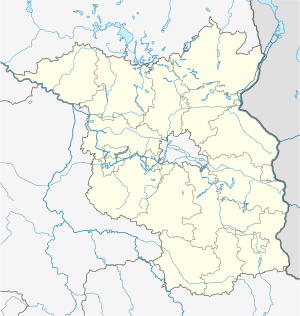Seegartenbrücke (Brandenburg an der Havel)
Coordinates: 52 ° 24 ′ 3 " N , 12 ° 24 ′ 43" E
| Seegartenbrücke | ||
|---|---|---|
| Seegartenbrücke | ||
| use | Street | |
| Convicted | Koenigsmarckstrasse | |
| Crossing of | Wendtsee / Elbe-Havel Canal | |
| place | Brandenburg on the Havel | |
| construction | Warren Girder Truss Bridge /
Truss bridge with continuous girder |
|
| Number of openings | 3 | |
| start of building | May 17, 2005 | |
| completion | August 31, 2006 | |
| location | ||
|
|
||
The Seegartenbrücke is legally the last bridge to the Elbe-Havel Canal / Mittelland Canal . It leads over the Wendsee immediately west of the Plauer See , so near the meeting of two important waterways , the Elbe-Havel Canal and the Lower Havel Waterway . The Plauer See is part of the federal waterway Untere Havel waterway with the waterway class IV, for which the waterways and shipping authority Brandenburg is responsible.
history
Today's Seegartenbrücke leads the Koenigsmarckstraße from the northern tip of the Kirchmöser peninsula over the Wendsee to Plaue . As early as 1650, a bridge was built at the narrowest point of the lake by order of Georg Christoph von Görne, Herr auf Plaue. During the First World War , a powder factory was built in Kirchmöser West. In order to improve the traffic connections to the city of Brandenburg and to develop the newly created industrial area, a massive steel truss bridge, the Werkamtsbrücke , colloquially known as the powder bridge, was built in 1916/17 . Shortly before the end of the Second World War , the bridge was blown up by the retreating Wehrmacht . A pedestrian emergency bridge was not built until 1947 and could be used until 1954. In the years 1951 to 1954 the destroyed Werkamtsbrücke was rebuilt and after the traffic handover it was named Rosa-Luxemburg-Brücke , named after the representative of the European labor movement Rosa Luxemburg . Until 2005, it served traffic for almost 52 years. In 2005 the bridge was demolished and in summer 2006 the new three-span steel truss bridge was opened to traffic as a Seegarten bridge .
Name story
In 1915/16, the Seegarten officers' mess , a clubhouse, was built in Kirchmöser West, close to the bridge . The brick building was used, among other things, as the Hotel Seegarten with a ballroom and society house. Between 1928 and 1934 there was a cinema in the house. After 1950, the legendary Seegarten building served as the railroad workers' clubhouse . It was very popular with its numerous interest groups, including a male choir, its own chapel and a large number of events in the huge hall. Since 2008 there has been a project to renovate the vacant building.
See also
literature
- Hans-J. Uhlemann: Berlin and the Märkische waterways. Transpress Verlag, Berlin 1987, ISBN 3-344-00115-9 .
- Writings of the Association for European Inland Shipping and Waterways e. V. Various years. WESKA (Western European Shipping and Harbor Calendar), Binnenschifffahrts-Verlag, Duisburg-Ruhrort. OCLC 48960431
- Richard J. Dietrich: The fascination of bridges: architecture, technology, history. 2nd Edition. 2001, ISBN 3-7667-1511-9 .
- Herbert Stertz: Havel shipping under sail . From the fur boat to the chat boat. Media @ Vice, Pritzwalk 2005, ISBN 3-00-016065-5 .
- Herbert Stertz: Havel shipping under steam . Economic factor and experience. Media @ Vice, Pritzwalk 2006, ISBN 3-00-019924-1 .
Web links
Individual evidence
- ↑ The Seegartenbrücke at structurae.de/bauwerke
- ↑ Directory E, Ser. No. 60 of the Chronicle ( Memento of the original from July 22, 2016 in the Internet Archive ) Info: The archive link was inserted automatically and has not yet been checked. Please check the original and archive link according to the instructions and then remove this notice. , Federal Waterways and Shipping Administration

